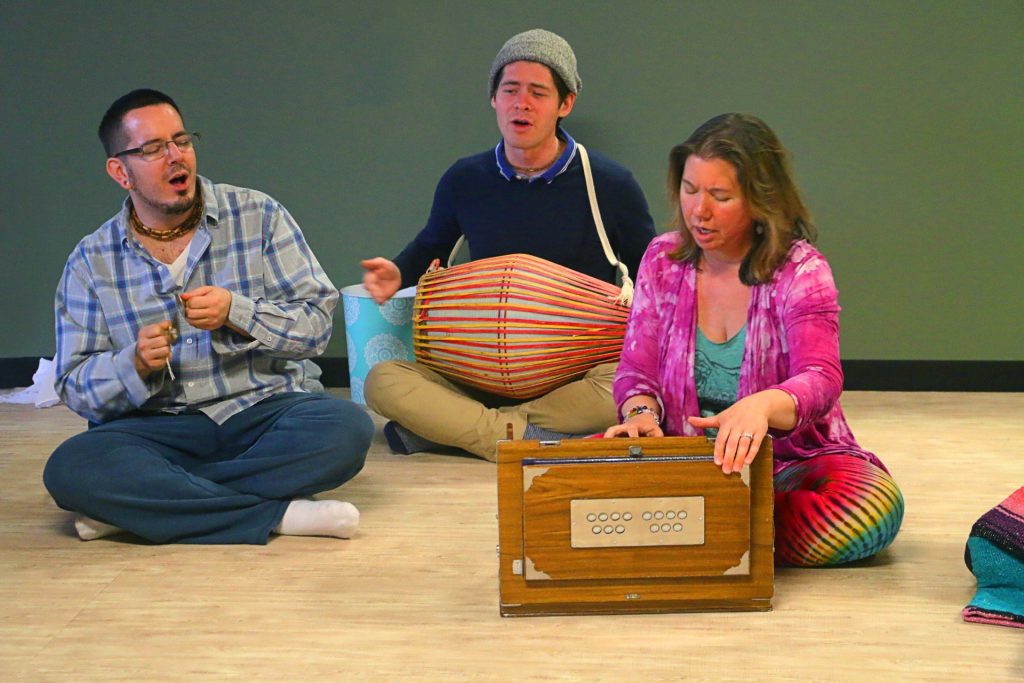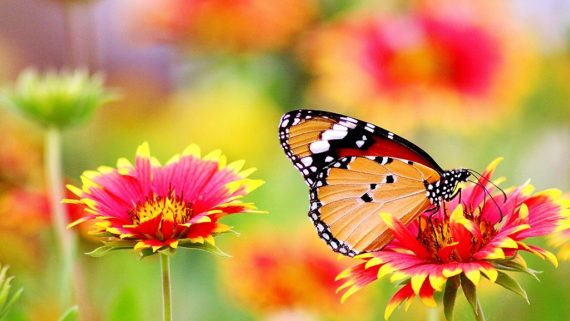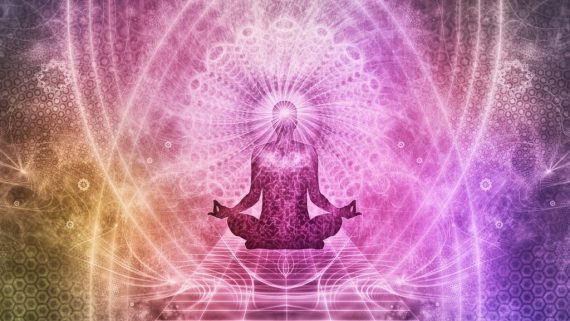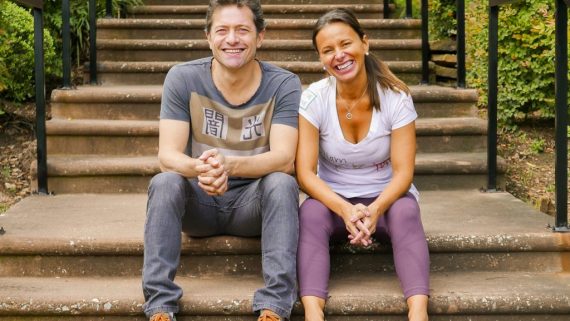Yoga Sanga with Lavanga
Yoga Sanga with Lavanga
Understanding the Hare Krishna Community
Photos: Lavanga singing Kirtan with friends at Atma Bhakti Center
Laura Lavanga Schlette holds a special place in Dallas Yoga Magazine’s heart. She is a sweet and loving soul who has found her passion and calling in the Hare Krishna community. Lavanaga’s commitment to her practice and guru is pure love. We are honored to share her interview with our readers.

Photo: Lavanga with her harmonium
DYM: Where are you originally from?
Lavanga: I was born in Denton and grew up in Grand Prairie. I’ve been in the Dallas area my whole life, with the exception of 1 year in New Mexico when I was 11, and a few years in Los Angeles in my early 20s. What can I say…Dallas is home.
DYM: What do you do as a career? Explain.
Lavanga: Well, I’ve been a licensed massage therapist for 24 years, and in that field, I’ve made my living in many ways – from working for others, doing outcalls, owning my own studio and teaching at a massage school for a while. But I’ve almost always had income coming from more than one source, which I like. Things like doing Reiki attunements, reading tarot cards or making jewelry. Even though massage is truly my dharma and I love it (and I’m really good at it, I’m told), my goal for the future is to further diversify how I make a living by developing other talents and interests and really putting myself out there.
DYM: Did you grow up in a religious home?
Lavanga: Oh my yes, I did. Born and raised Roman Catholic. Went to Catholic school from 1st-5th grades….taught by pre-Vatican 2 nuns, blue plaid uniforms, the whole bit! It was my identity up until I was 15 years old, when suddenly it all began to feel very hollow to me.
DYM: You are a Hare Krishna now. That is a huge jump from Roman Catholic, what lead you to that path?
Lavanga: Okay, I have to make this the Cliff Notes version…..let’s say it was a lifelong process. I remember at 8 years old beginning to doubt the Catholic Church had all the answers for me. I can see now that’s when things really began. By the time I was 15, I no longer internally identified as Catholic. My first encounter with the Hare Krishnas was the summer I turned 17, and my friends and I first stepped in to the Dallas temple in December of 1986. I immediately felt most everything about the philosophy to be true, but I was in no place to take up any kind of serious practice. After all, I had just recently shed an identity that had felt kind of forced upon me for my entire life up to that point. So, over the next 17 years, I studied and participated in all kinds of paths – New Age, Pagan/Wicca, Buddhism, Native American studies…you name it, and now I’m really glad I did that. But in 2000 when my mother passed away, I began feeling the need to give up the “little bit of this and that” mentality. I realized that no matter what tradition I followed, the only way to experience the deep connection I was looking for was to pick one and dig deep. Though I never 100% abandoned the Hare Krishna/Bhakti tradition, at that point, it was very obvious which path I had to dive into, and spent the next 2 years re-connecting with the practices and the people. In 2002, I met my Guru and that sealed the deal completely. I took formal vows of commitment in 2004.
DYM: That is so wonderful to find your passion and your path. People are always curious about the Hare Krishna’s. I know it’s difficult to explain religion, but can you share some of the philosophies you love about it.
Lavanga: We’re called “Hare Krishnas” because that’s what we chant. So, Krishna is a name of God that means “all-attractive,” and “Hare” is a way to call on the feminine energy of God. I like that part of it – we recognize ultimately God is as much Female as Male. We call what we practice “Krishna Consciousness” because the goal of our lives is to become conscious of a reciprocal relationship with God we’ve always had but forgotten. To do that, we learn how to spiritualize all of our daily activities. It is so practical! We all want happiness, right? The root cause of our suffering is feeling separated from God’s love. And no matter how much we try otherwise, nothing else but God’s love will fill that hole in our hearts, because it is unlimited. So, the goal is to remove the barriers the barriers which are blocking us from experiencing the happiness that only comes from loving exchanges with God. And to start this process, you take what you already do, but just switch the reason you’re doing it. That’s really magical, because with this mentality you’ll see how God’s loving hand is directing everything in your life.
DYM: Tell us something about the Hare Krishna’s most people would not know.
Lavanga: The term “Hare Krishna” is not really the name of what we practice. I don’t think most people know that. The actual tradition we follow is called “Gaudiya Vaishnavism.” which is referring to our teacher lineage which actually pre-dates Hinduism, making Hinduism an off-shoot of our tradition, not the other way around.
DYM: The temple has an amazing vegetarian restaurant and one of my favorites… Kalachandjis, they have the best food! Are you a great vegetarian cook?
Lavanga: I don’t mean to toot my own horn, but yes… I’m a great cook! My love of cooking began at a very early age helping my father in the kitchen. He was an amazing cook, as was his mother…so I come from a good lineage there too. We grew up eating Asian style – my father was raised in Indonesia – rice and veggies were always the centerpiece of our meals. I adore everything Asian – Chinese, Vietnamese, Thai, Japanese. I’m more picky about Indian food but I do love South Indian dosas and idlis. I cook all styles- Mexican, Italian, etc., I love to bake, especially cookies and muffins. I’m also really good at cooking without grains and beans. Twice a month we observe days of fasting for health and spiritual benefits. It’s really fun figuring out how to how to make the things we usually eat from different ingredients. For instance, if you look in my pantry, I have a half a dozen or so different kinds of non-grain flours that I experiment with….I love it!
DYM: How long have you been a vegetarian? Was changing your diet hard when you first became one?
Lavanga: I became a vegetarian about a month after first going to the Hare Krishna temple, so that was 32 years ago. I had actually toyed with it a couple of years earlier when I learned Paul McCartney was a vegetarian, but alas, that wasn’t enough to keep me at it! But when I met the Hare Krishnas and learned about spiritual reasons to not eat meat, it was easy to make the switch, and it’s been an easy thing to maintain. Not in the sense of there’s always plenty to eat in all situations, but in the sense that I don’t feel tempted because it’s connected to my deepest spiritual convictions. Plus, when you hang around the Kalachandji’s community, there’s so much good food around, there’s no reason to eat anything else!
DYM: I have to agree. I could eat at Kalachandjis every night. If I remember correctly, was your guru in town recently? How did this person become so important to you and how has he impacted you?
Lavanga: He was here recently. I’m super lucky because he spends at least 3-4 months in Dallas every year, so I get to spend a lot of time with him. By the time I met him, I had been around the Hare Krishnas for almost 20 years, but I had a deep fear of committing myself fully, and I beat myself up internally about that for long time. Spiritual life to the degree I wanted to take it seemed difficult and unattainable. But when I met him, it all of a sudden didn’t feel difficult anymore. There’s no other way to describe it. It was like a light switch got turned on and those fears totally dissolved. Suddenly taking vows to become his formal student became the only thing that mattered in the whole world. He’s like a father and a best friend all in one. He teaches so much by his example, and encourages me in the things he sees me enthusiastic about. Plus, he’s so funny and sweet. Just ask anyone who has met him! He also gave me my name, which is super special. You get a spiritual name at the time you make the formal commitment vows. So, every time my name is used, I get a chance to remember something he gave me.
DYM: That is special. We are looking forward to meeting him someday. Can you explain to the readers the tradition of changing Kalachandji’s clothing and what it means to you to be able to do this for the temple?
Lavanga: Like I said before, Krishna Consciousness is about re-kindling our relationship with Krishna because ultimately God is a person. Changing someone’s clothes is a very personal and intimate thing. Spiritual life is very alive and dynamic, and when I’m up on the altar I can feel love emanating from Kalachandji. I do a lot of praying and meditating up there. I’m artistic, and it’s a really good outlet for my creative side, coordinating the jewelry with the outfits, etc. But even more than the pleasure I get from it personally, I love how people react to the Deities when I dress them. I love when visitors come to the temple and take photos of the altar. I feel like I helped them have a lovely experience they get to take home with them. The other thing that makes it special is in order to do this service, you have to be a priest. Being brought up a Catholic girl, becoming a priest was something you could only dream about. But in our tradition, it is open to everyone who wants to take up the extra vows that go with it.
DYM: The altars are so amazingly beautiful at the temple. I bring my friends of all different faiths to experience it. The feel and the beauty of it is extraordinary. Tell us about your daily spiritual rituals.
Lavanga: Mantra meditation on a mala is my main practice and the primary vow I made to my Guru. Private meditation like that is called japa. The mantra I chant is the maha-mantra, you know, the Hare Krishna mantra….Hare Krishna, Hare Krishna, Krishna Krishna, Hare Hare, Hare Rama, Hare Rama, Rama Rama, Hare Hare. They are all various names of God we chant in the mood of offering ourselves in service. That is the meaning of Bhakti, offering your entire heart to God. It takes me about 1-½ hours a day. Chanting them all at once in the early morning is the goal, but not always the reality! Also, all the food I cook at home is blessed with mantras before we eat. I don’t even taste while I’m cooking, because God gets the first taste. This is a skill that takes some trial and error to get right. This is also one of the secrets as to why the food at Kalachandji’s is so amazing. They do it the same way. Chanting and eating are the two main practices of Bhakti Yoga.
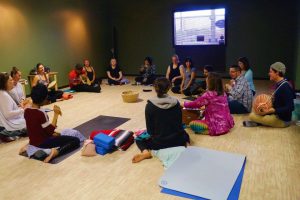
DYM: You plan and organize events at the Atma Bhakti Center in Dallas. Tell us about the place and some of the events you have there. Do you have any upcoming events?
Lavanga: Atma Bhakti Center is my little home away from home. It is a renovated duplex that’s only a block from my house, which is right on the border of Hollywood Heights near Lakewood in East Dallas. One side has a full kitchen with tables and a little sitting area where we host Ayurveda and vegan cooking classes. The other side has a large empty room with high ceilings where mostly yoga classes take place. Behind the yoga room is a small room that’s my primary place of doing massage and healing work. We recently took the word “yoga” out of our name because we are more of a community center than what people normally think of as a yoga center. The hatha/asana yoga we do have is mostly gentle and restorative, though we have recently added a Sivananda style yoga class on Saturdays, as well as a Kundalini class. We also of course offer a lot of bhakti yoga. We have weekly Bhagavad Gita readings and host kirtans (the yoga room has amazing acoustics). We regularly rent out the space for workshops and classes too. There is a real need in the community for an inexpensive space for those who want to teach their healing or meditation classes and events. We’ve found that’s a niche for us. As far as upcoming, we always host a summertime community market with local vendors, though we haven’t set a date for that quite yet. If anyone has an event that they need a space for, let me know!
DYM: You play the harmonium! How did you learn to play it?
Lavanga: Honestly, primarily YouTube videos! You can really go down a rabbit hole if you start looking for kirtan tunes there. I also subscribed to something called the Bhakti Breakfast Club for a few months, which is a really great resource. They teach you basic techniques and theory plus they share how to play popular kirtan tunes by people such as Krishna Das and Jai Uttal, so you can start kirtan-ing right away. I’ve been playing guitar off and on for years, so having a basic working knowledge of music helped, but if you learn a couple of chords, you can go a long way with just that.
DYM: When you play the harmonium, you sing Kirtan. Can you explain to our readers who don’t know about Kirtan what it is and why it’s so important to you?
Lavanga: As I’ve mentioned earlier, my main practice is mantra meditation. So, if chanting alone is powerful (which it is) then chanting with a whole bunch of other people is even more powerful! It really amplifies the power of the mantras, not to mention the fun of adding music to the mix. What does it say in Psalms… “when two or more people are praising my name, I am present…” that’s what Kirtan is. The classic format is there is a leader who will sing the melody of the mantra, then everyone else sings in response, then the leader will sing it again, then response again…and so on and so forth. What this does is generate an exchange of love between the “leader” and the “responders” which raises the vibrational energy and really opens the heart. The key in kirtan is participation – it isn’t a musical performance, it is actually prayer. My desire when I lead kirtan especially, is to simply be a channel for this perfect spiritual energy to come through. When I sing in that mood, you can feel that kind of energy coming back from the responders. When a kirtan really gets going and everyone is singing loud and from the heart, it transports you into another world. Oh, and then dancing can happen too! Dancing and singing as prayer….yeah, there’s nothing else quite like it.
DYM: You are speaking at the Cosmic Yogi Festival about the importance of mantras. Will you share why you use mantras and can anyone benefit from it?
Lavanga: The best thing about using mantras is they are so practical. And when I say “mantra,” I don’t mean an affirmation, I mean the potent spiritual sound vibration that is present in Sanskrit mantras. Mantra meditation can be done anywhere, anytime in any circumstance by anyone. The word itself is broken down like this – “man” refers to the mind and “tra” means ‘to free’ or ‘to deliver.’ We’ve all had experience where our mind takes us all kinds of places we don’t want it to go. Or we may be in a situation we can’t physically get out of, but we can mentally get out of that space. Either way, the “mind-freeing” mantra can get us out of that and take us to a safe, spiritual place. You can say it silently or scream it from the rooftops…it all works the same.
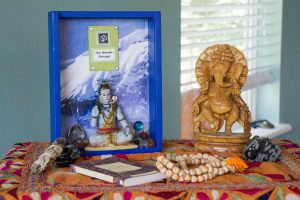
DYM: You make “prayer boxes” decorated with Krishna, Buddha and other spiritual leaders. We have one you made on our altar. They are so colorful and joyous. They are filled with so much positive energy! Can you tell everyone what makes them so unique?
Lavanga: My altars and prayer boxes are an extension of what I do on the altar at Kalachandji’s. Not everyone can go up on the altar, so I bring Kalachandji to you! The Deities are decorated with costume jewelry which over time breaks. Because the jewelry has touched the Kalachandji who has been the recipient of so much love, that energy, that Shakti becomes a part of the jewelry. Every altar I make has quite a lot of this broken jewelry incorporated into the design, so you get the energy too! I like making altars with personalities other than Krishna such as Buddha, Saraswati, Ganesha, St. Francis, Archangel Michael etc., because people resonate with different spiritual energies and I want to honor that. They are also made with various crystals and semi-precious stones which enhance the beauty and energy of the altars. They are so much fun to create, and most of the time I’m listening to spiritual music and singing while I’m making them, so they get infused with mantras and a lot of love. I also make custom ones by request. Those are the most fun to make. Co-creation is something I’m really in to.
DYM: How do you see yourself as part of the larger yoga community in Dallas and what do you hope to bring into the Community?
Lavanga: What’s super exciting now about the yoga community is that it’s really starting to expand into “the rest of yoga.” So many people have started, as most do, with the physical part – the asanas. Now those same people have been practicing that for a while, and it’s a very natural next step to become open to learn about the whole lifestyle and philosophy side of yoga. To learn more about vegetarianism, meditation and yogic texts such as the Bhagavad Gita. So, that’s where I and the Atma Bhakti Center come in. We want to be resource for those who want to learn more about yoga “beyond the asanas.” My personal desire is to see aspects of Bhakti yoga incorporated in to more and more classes, and kirtan spread wider. Wouldn’t it be fantastic if a short kirtan after class was kind of “the norm?” I think it would be amazing! So, one way that I’m personally going to do that is begin offering what I call “Yoga Sanga with Lavanga.” It’s a class that offers a complete yoga experience. We’ll start with some intentional, prayerful asana, then have a short kirtan. After that, we’ll discuss a verse or concept from the Bhagavad Gita. We’ll end the gathering with a vegan, sattvic meal. What’s a sattvic meal? Come to one of the classes and find out! I don’t have dates yet, but they will be popping up on the Atma Bhakti Center calendar (and other yoga centers calendars) later this summer!
DYM: Count us in! Your journey is remarkable, and we so appreciate you sharing it with us. Thank you. Namaste.
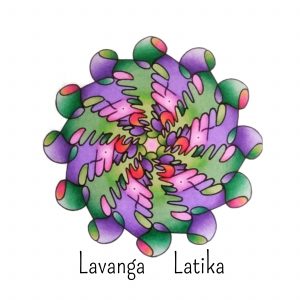
Contact Information for Lavanga:
Website: www.atmabhaktiyoga.com
Social Media:
Facebook: Atma Bhakti Center
Facebook, Instagram and Etsy: Lavanga Latika (personal page for altars, etc.)
Email if you desire: [email protected] (I do love email)
Address for the Atma Bhakti Center: 6315 Lindsley Ave., Dallas, TX 75223

